Menu
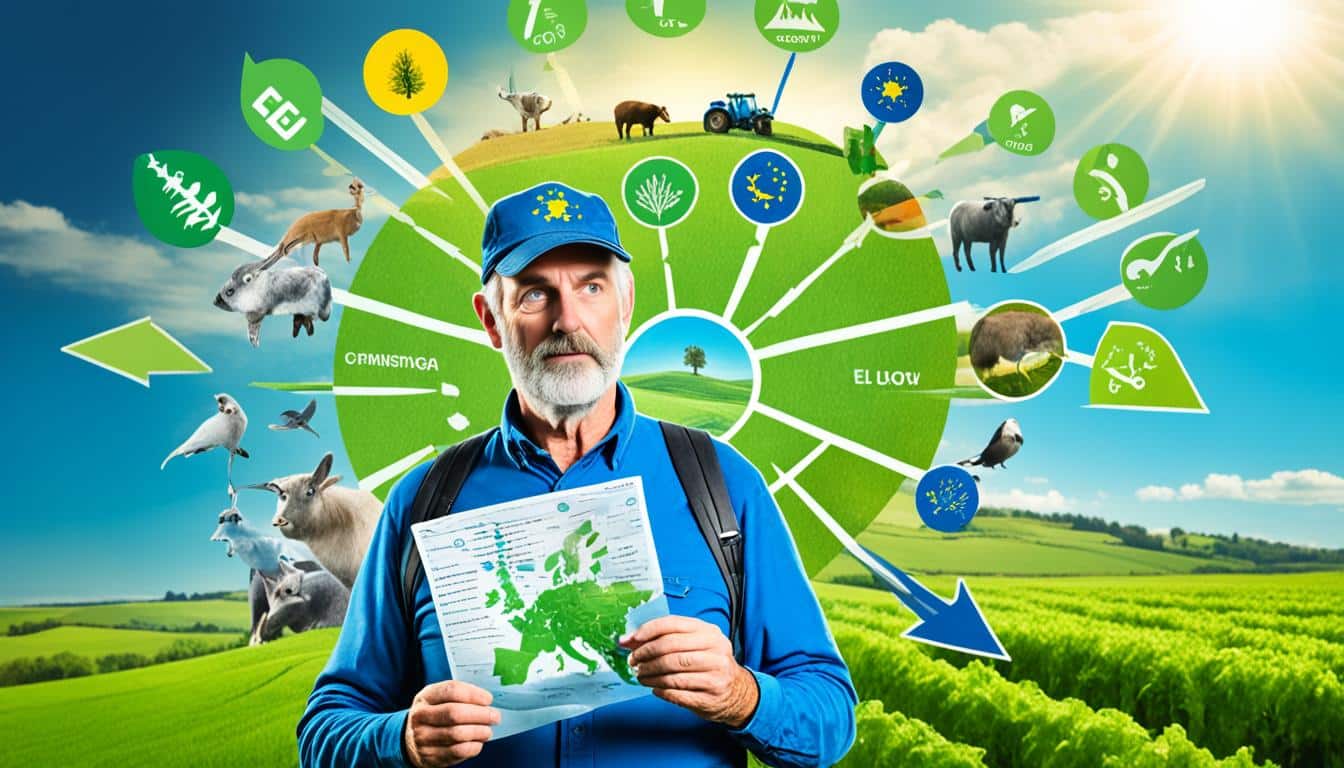
Did you know the EU wants to cut greenhouse gases by 55% by 2030 compared to 1990 levels? This big goal shows how the latest rules will impact Irish farmers. Changes to the Common Agricultural Policy (CAP) match the European Green Deal. They aim to meet social, environmental, and economic goals. With a big budget of €307 billion for 2023-2027, the CAP aims to help farmers and protect the environment. It will provide financial support and push for more sustainable farming. The effort to improve farming with technology aims to make it more efficient and able to adapt.
Farmer protests highlight the need for rules that are easier to follow. So, the European Commission started a review to make the CAP simpler. This review wants to give farmers better tools and flexibility, especially for dealing with bad weather and other tough times. The main aim is to keep farming going well for the long run while caring for the environment.
The EU has made big changes to its environmental regulations lately. These updates began with the Common Agricultural Policy in 1962. Irish farmers now must meet new rules. These changes affect how they farm and deal with things like market competition and subsidies. The CAP 2023-27 has a huge budget of €307 billion. Most of this money comes from the EU.
Now, members of the EU can move part of their funds to help with different farming needs. This change fits with the EU’s big goal to be climate-neutral by 2050. It means Irish farmers need to focus on sustainable practices. These aim to meet high environmental standards.
The EU’s single market lets farmers in Ireland sell freely across Europe. This helps by making trade easier and boosting economic growth. But it also brings more competition and the need for everyone to follow the same strict environmental rules. Through checks, like the PMEF, the EU ensures each country is doing its part well.
The EU aims to simplify the CAP rules, especially after a review in March 2024. They’ve listened to farmers’ needs and made changes to support them more. Now, there’s less paperwork and more help, especially in tough weather.
These new regulations are about making farming in Ireland better for the long run. Initiatives like the Farm to Fork plan push for organic farming and less food waste. The end goal is to support farming that can last, despite the quick changes in the rules.
The European Green Deal will change how agricultural practices in Ireland work. It aims to match severe environmental aims with economic plans. All within the CAP’s structure. The plan plans for a future-proof agricultural sector with several goals and actions.

The EU wants to plant three billion trees by 2030 and fix over 25,000 km of rivers under the European Green Deal. It also aims to cut nutrient losses by 50% while keeping soils fertile. These steps are key to boosting sustainable farming methods and protecting nature.
The Farm to Fork Strategy is a major part, pushing for eco-friendly food systems. It looks to reduce chemical pesticides by half before 2030. Also, it wants 25% of EU farming to be organic by then. This approach highlights the value of organic farming for safe food and the planet.
There are big money investments too, like spending at least €100 billion from 2021 to 2027 in changing to a greener economy. This cash is for regions most hit by these changes. It helps support agricultural practices that are good for the earth.
Plus, there’s the Renewable Energy Directive, which supports next-gen biofuels from non-reusable waste. It aims for a big cut in greenhouse gases – at least 55% less by 2030 compared to 1990. This is all part of the EU’s bigger goal to hit zero emissions by 2050.
The CAP 2023-27 intends to make farming more sustainable and efficient in the EU. It looks to meet the changing needs of farmers while leading a move towards a greener sector. We will look into how it helps Irish farmers and how their progress is checked.
In Ireland, the CAP wants to strengthen agriculture by using funds from the EAGF and EAFRD. These funds help farmers directly, improve the market, and support rural growth. They aim to meet local farming needs and help farmers live fairly. About 163,600 jobs in Ireland’s food and farming come from this.
There’s been a big rise in money for rural development initiatives, now over €2.3 billion. With €9.8 billion from Ireland’s CAP plan, a lot is being done to boost productivity and sustainability. This includes schemes like ACRES and the Organic Farming Scheme to help the environment and smaller farms.
The CAP checks its success by looking at specific goals through 44 indicators at the national level. This way, farmers and rural areas follow the CAP’s rules. The CAP is based on EU laws.
Monitoring these indicators matters a lot. For example, from 2014 to 2020, CAP funds helped improve life in rural areas. This included better technology and services for 18 million people. This ongoing check-up helps farmers meet EU environmental standards. Also, the CAP will have money set aside each year to handle future farm problems.
Sustainable farming in Ireland is changing quickly due to tough rules from the EU. This switch makes Irish farmers use methods that help crops grow and keep the environment safe.
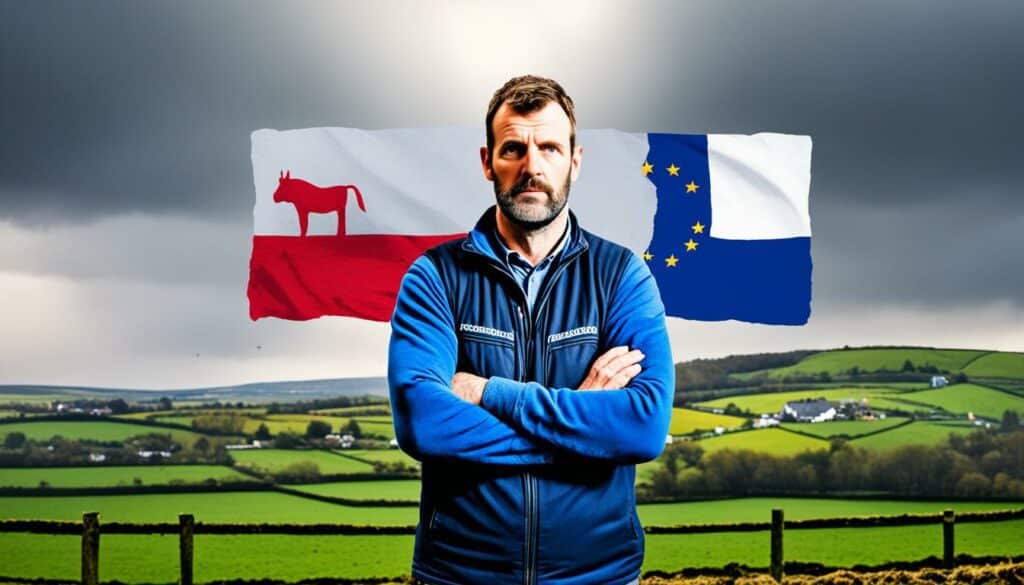
Irish farmers now face strict rules on using pesticides and fertilisers. The EU wants to cut pesticide use by half before 2030. It also aims to have no more greenhouse gases by 2050. This will help save plants and animals, and keep us healthy.
The Farm to Fork strategy also says a quarter of Europe’s farms should be organic by 2030. It wants to use less pesticide and fertiliser to protect nature and people.
Ireland is working hard to make its farms better for plants and animals. The EU’s Biodiversity Strategy wants to stop the loss of nature and fix damaged lands. It plans to plant three billion trees and fix 25,000 km of rivers by 2030.
Irish farmers are learning to balance making food with caring for nature. They are protecting local plants and animals. This keeps the land healthy.
| EU Targets | Goals | Measures |
|---|---|---|
| Climate Neutral by 2050 | No net greenhouse gas emissions | Investments in green technologies, renewable energy transition |
| Farm to Fork Strategy | Sustainable food system by 2023 | Reduce pesticide use, increase organic farming, boost biodiversity |
| Biodiversity Strategy 2030 | Halve pesticide use, repair ecosystems | Plant 3 billion trees, restore 25,000 km of rivers |
Adjusting to these new green rules brings challenges and chances for Irish farmers. With good plans and help, farming can do well and help the Earth a lot.
Irish farmers need to keep up with new environmental rules set by the EU. These rules match the European Green Deal and the CAP. Following these rules is key to keeping farming sustainable and the environment safe.
A big part of the CAP budget, about €98 billion, goes to helping the environment. This money supports actions that improve the environment, fight climate change, and protect animals. Small farms, which are 65% of CAP’s help and are under 10 hectares, get some breaks on following these rules. This helps them do their part in protecting the environment.
Farmers are encouraged to use less harmful ways to grow their crops. They get advice on how to avoid damaging the environment. There are also some exceptions for the way they grow certain crops. This includes rules about the soil, crops, and ways to vary what they grow. Adding to this, there are plans to make trading more fair. This should also make it easier for farmers to follow the rules.
Ireland and other EU countries have to make a plan to fix damaged natural areas within 24 months. This plan must show how they’ll meet certain goals by 2030 and beyond. Checking the environmental impact is a big part of making sure farms are being responsible.
There’s a plan to increase how many times the CAP rules can change each year. This is to help farmers keep up with new ways to protect the environment. This change is good because it lets farmers better meet tough regulations.
The EU environmental regulations are affecting farmers in a big way. They face more challenges along with rising energy costs and competition from cheap imports. This has led to a lot of worry and frustration among farmers.
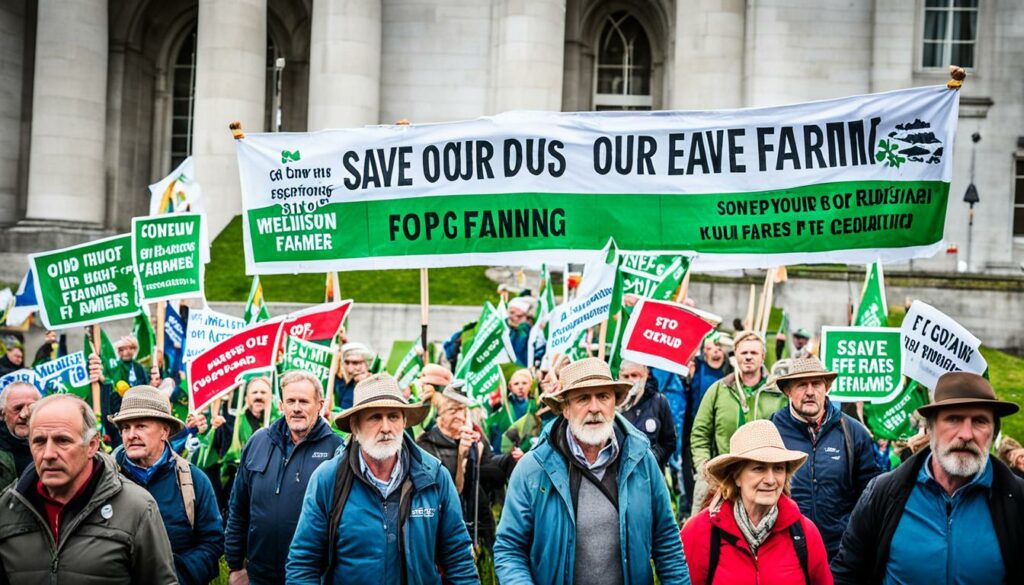
Across Europe, farmers are worried about the new environmental rules. For example, in Berlin, 30,000 protestors and many tractors caused a city centre standstill. In France, during the “siege of Paris,” hundreds of tractors blocked roads into the city on 29 January.
In Belgium, farmers blocked roads in Brussels and gathered outside the European Parliament on 1 February. They did this to show how frustrated they are. These farmers demand their voices to be heard and for the rules to change.
The rules of the European Commission are proving difficult. They have proposed delaying some rules. This includes the need for farmers to leave land for nature and soil’s health.
This delay aims to help farmers cope better with the changes. But, deals like the EU-Mercosur trade agreement and the free trade extension with Ukraine are making their lives harder. These deals increase the arrival of cheaper farm products to Europe.
In Ireland, farmers protested on 1 February with European farmers. They are worried about the high costs of meeting the strict environmental rules. They want the rules to be fairer and more supportive to farmers.
| Country | Protest Actions |
|---|---|
| Germany | 30,000 protestors and thousands of tractors in Berlin’s city center |
| France | Hundreds of tractors blocked roads into Paris during the “siege of Paris” |
| Belgium | Farmers blocked roads in and out of Brussels, later gathering outside the European Parliament |
The issues such as unfair competition, high costs, and strict rules are very important in these protests. The European Commission’s steps to postpone some rules are a start. But, more must be done to really help the farmers and solve their concerns.
The EU’s farm policies have greatly impacted rural growth in Ireland. They’ve blended financial support with efforts for a future-proof farm sector. These measures cover a large part of Ireland’s agricultural land, about 64%.
The Common Agricultural Policy (CAP) has a big budget, totalling €307 billion for 2023-2027. This fund mix includes €264 billion from the EU and €43 billion from various countries. This allows countries to move up to 25% of their CAP budget between direct support and rural development funds.
Funds from the EAGF and EAFRD are key for supporting strong rural economies. They encourage sustainable farming and better countryside infrastructure. Each country’s CAP plans are checked by a special system to make sure they work well and meet goals.
Making farms economically strong is vital in the changing rules. In Ireland, this helps 127,000 farmers on 135,000 farms. Direct supports boost their competitiveness and work efficiency.
Adapting to EU green rules is tough, but Irish farms can still thrive. They get the support and investments needed for growth.
The Irish Government is key in making sure that EU environmental regulations work smoothly for Irish farmers. It’s committed to making sure Ireland meets the strict environmental standards set by the EU. The government watches over the National Strategic CAP Plans carefully. These plans help tackle local issues and create strong agricultural practices that fit Ireland’s unique needs.
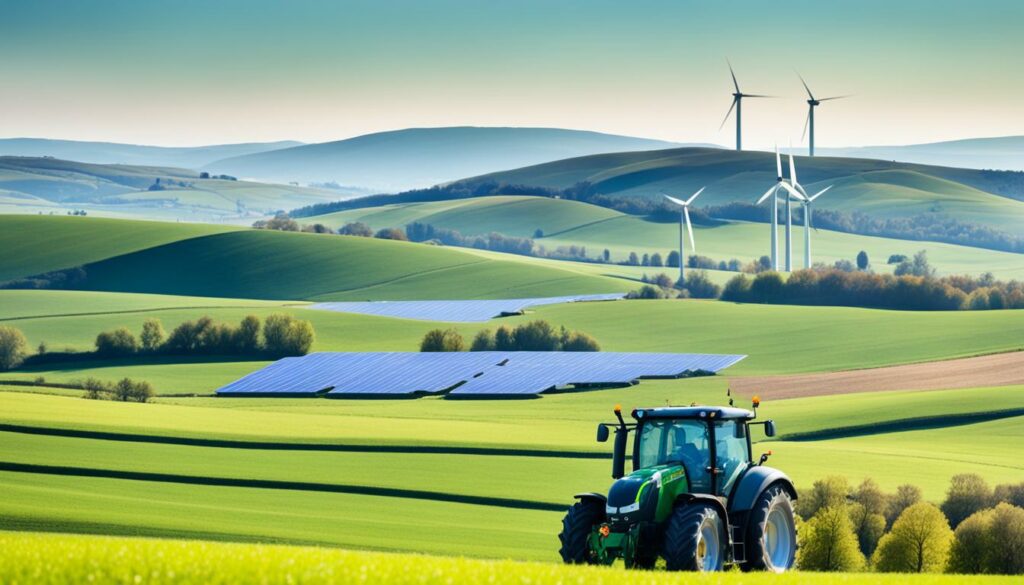
When Ireland joined the EU on 1 January 1973, it was a big step forward, with 83% of votes in favour. Since then, the Irish economy has changed a lot. For example, the services sector has grown from employing 45% of people in 1973 to 77% in 2022. These changes have also influenced how agriculture meets EU environmental regulations.
The increase in GNP and GNI per capita is also impressive. It rose from just over €17,000 in 1973 to almost €66,000 in 2022. This economic growth shows why it’s vital to have up-to-date agricultural practices that follow EU rules. The Irish Government makes sure these practices are good for the environment and help farmers make more money.
The CAP 2023-27 plans to spend close to €10 billion in Ireland’s farming and rural areas. Around 60% of this money helps farmers directly. The other 40% supports projects for rural development. The Irish Government plays a big part in wisely using and giving out these funds. This way, farmers get the support they need to do well under the new rules.
The government also helps farmers stay informed about policies and work well with them. With efforts like this, the balance of trade, especially in goods, has shifted positively. This success shows how Irish policies have blended with the EU’s goals over the years.
Addressing farmers’ present worries is an important part of the government’s work too. It helps them with clear support and flexible rules. This way, EU environmental regulations become more about growth and green advances in agricultural practices. This makes farming more sustainable and eco-friendly.
The adoption of sustainable farming practices by Irish farmers is crucial. It helps them meet tough EU environmental regulations. They are using eco-conscious methods that make both environmental and business sense.
Beginning in 2023, 25% of direct payments will go to eco-schemes until 2027. These eco-schemes encourage farming that’s good for the climate and environment. Farmers can choose to join yearly or for longer.
For the first two years (2023-2024), if farmers aren’t signing up enough, a country can spend less than 25% on eco-schemes. But by 2027, this gap must be made up.
There’s also a new rule that lightens the load for farmers with fallow land. This rule change makes farming operations more flexible. It’s part of a plan to make life easier for farmers and strengthen their role in the food supply chain.
The Common Agricultural Policy (CAP) 2023-27 has seen big changes. It makes financial support fairer, with a massive €307 billion budget. Member States can move up to 25% of their funds to better support farmers.
Now, each country can make its own plan to support farming and rural areas. They use a system to check if these plans are working well. This helps them reach their farming goals effectively.
Irish farmers are seeing real benefits from these plans. They are getting support to farm in ways that are good for the earth. A policy review in March 2024 should make things even better for them, especially in tough weather.
Irish farmers must follow strict environmental rules. These rules, from the EU, aim to keep farms productive yet eco-friendly. It means they have to carefully manage how they farm, both now and in the future.
The EU understands the tough balance farmers face. So, it lets them use some special strategies. These include the ‘Eco Scheme’ and the Code of Good Agricultural and Environmental Practice. A quarter of their Basic Payment supports initiatives for nature preservation.
This help is key. It keeps farms productive while also looking after the environment.
Changes in the rules also take into account more extreme weather. These steps help farmers get ready for the effects of climate change. For example, creating areas called ‘Space for Nature’. This aims to make farms more resilient against extreme weather.
A new scheme, ACRES, is helping with this. It’s already received applications from 46,000 farmers.
Irish farmers are working hard to protect the environment. They have used the GLAS scheme to plant lots of wild spaces and grow long stretches of hedgerows. This has benefitted birds a lot. In fact, bird numbers went up by 19% during this time.
| Programme | Achievement |
|---|---|
| GLAS (2014-2020) | 19% increase in the Farmland Bird Index |
| ACRES | 46,000 farmer applicants |
| Space for Nature | 12-14% of farm areas qualified |
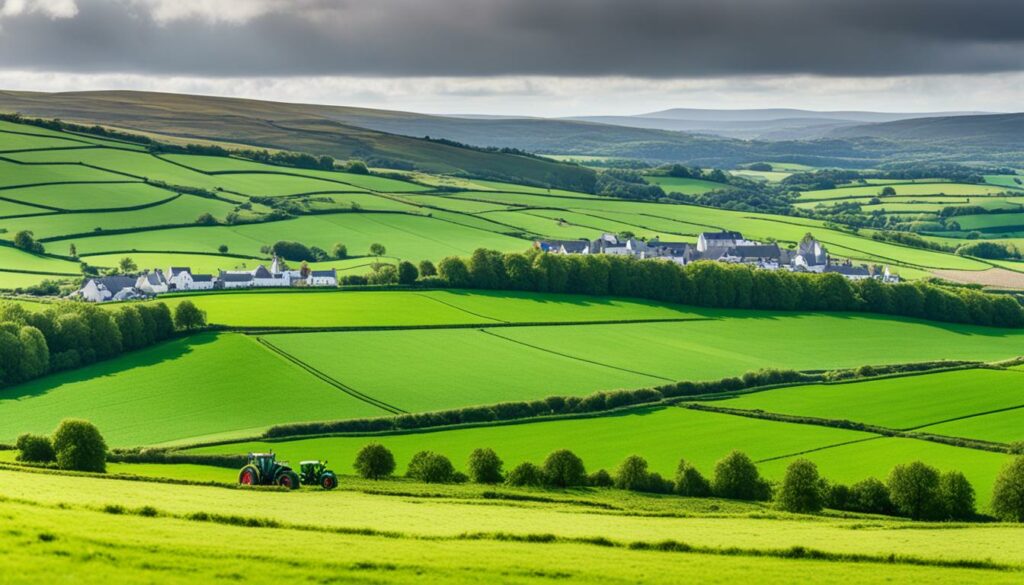
In the end, the rules are about more than just ticking boxes. They help farmers and the environment work together. This approach is preparing farmers for the future’s weather challenges.
An environmental impact assessment is key for Irish farmers. It makes sure their farming is in line with EU rules. This process checks for and deals with harm to nature from farming.
Checking the environmental effects has many pluses. It lets farmers know the results of their actions, such as changing land use and drainage. This leads to following EU rules and better, greener farming for the future.
Farmers in Ireland must meet EU environmental regulations. These rules, like the Environmental Impact Assessment Regulations, help decide when an assessment is needed. By following these guidelines, farmers control their environmental impact within EU standards.
The right steps to prepare an Environmental Impact Assessment Report must be taken. This includes using experts. Also, telling the public early about these assessments and giving clear info through an EIA Portal shows a commitment to openess. This overall strategy makes farming both rule-friendly and good for the environment.
Irish farmers follow EU environmental regulations to farm sustainably. These rules focus on high compliance requirements and environmental standards. They aim to make farming greener. This helps the EU meet big goals, like cutting greenhouse gases by 55% before 2030.
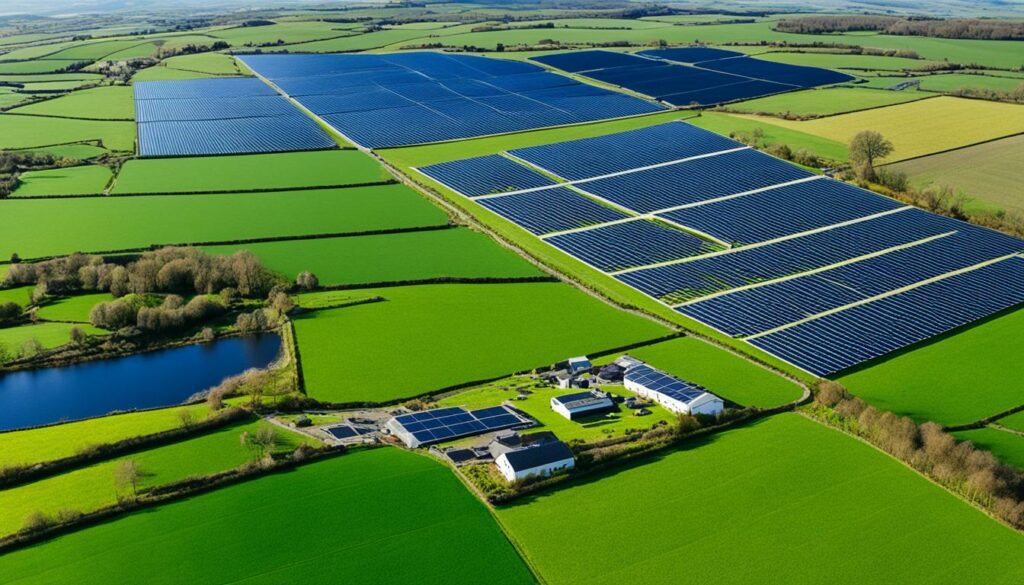
Farmers must work on conservation. The main effort is the EU Nature Restoration Law. It wants to fix 80% of wetlands, rivers, and important natural places in Europe.
They also have to use fewer pesticides and fertilizers. The EU Farm to Fork Strategy encourages organic farming. It also wants to lower antibiotics in animals.
Support funds like the Just Transition Fund help farmers go green. They ease the costs of going eco-friendly. Support from farming schemes helps, too. The Common Agricultural Policy invests about €10 billion in Ireland’s farms.
Reducing emissions is a big challenge. Dairy farms are a particular focus. They produce more emissions than beef or tillage farms. Ireland has to work hard to cut ammonia levels to meet EU climate goals.
Fighting for biodiversity is also key. About a third of Ireland’s farmland is highly important for nature. Keeping these areas up supports the environment and the farms.
Here is a table showing EU regulations’ key parts for Irish farmers:
| EU Regulation | Key Objectives | Impact on Irish Farmers |
|---|---|---|
| Fit for 55 | 55% reduction in GHG emissions by 2030 | More focus on cutting farm emissions |
| REPowerEU | 90% reduction in emissions by 2040 | Harder rules to cut emissions |
| EU Nature Restoration Law | Fix 80% of ecosystems | Important for keeping farmlands biodiverse |
| Farm to Fork Strategy | Use less pesticide, promote organic farming | Push for greener farm methods |
| Common Agricultural Policy (CAP) | Support sustainable farming and rural development | Offers financial support for green efforts |
Farmers help EU goals by sticking to these regulations. They not only meet rules but also support sustainable farming and help fight climate change.
Looking ahead, there are big changes coming for Irish farmers due to EU environmental rules. These changes aim to boost sustainability and bring in new digital methods. It’s not just about doing things differently but also smarter.
The EU and its members want to make sticking to rules easier for farmers. They’re working on plans to cut down paperwork. The goal is to help farmers follow the rules with less hassle. This should make running their farms smoother and less complicated.
By 2027, we’re likely to see some pretty big shifts in the rules. These changes will push for more eco-friendly and digitally advanced farming. The aim is to make the EU’s rules easier to deal with, so they don’t overburden farmers.
Articles 6(3) and 6(4) of the Habitats Directive, along with the Planning and Development Act 2000, play a critical role in shaping these policies.
They’re getting input from all kinds of people, like environmental groups and farmers. This helps make the new rules practical and on point. Working together, they’re aiming to take care of both farmers’ jobs and the countryside.
| Key Areas | Current Regulations | Anticipated Changes by 2027 |
|---|---|---|
| Compliance Process | Complex and Time-Consuming | Simplified and Streamlined |
| Policy Focus | Environmental Standards | Digital Innovation and Sustainability |
| Stakeholder Involvement | Limited Consultation | Inclusive and Collaborative Feedback |
The recent EU rules on the environment will change Irish farming. This will bring huge chances for growth and long life. Farming affects Ireland’s nature, using water, air, and creating greenhouse gases. So, it must follow strict rules. About 33% of Irish farms are of High Nature Value. This shows the new rules can bring big environmental benefits.
Irish farmers deal with big emissions differences between farm types. Dairy farms, on average, emit a lot more than beef or tillage farms. This big difference in emissions says we need to change our plans. The current way of cutting emissions doesn’t fit with our goals for 2020 and 2030.
Ireland has gone over the allowed limits for ammonia. This is because of more cattle and too much nitrogen use. This mistake shows we must seriously follow the new EU goals. These goals include saving 30% of land for nature by 2030. They also aim to fix at least 20% of land and sea areas by 2030. All places that need fixing should be restored by 2050.
The future of Irish farming needs changes, innovation, and team work. Following the new environmental rules will require big shifts in farming methods. The Irish government and the EU will help farmers change. They aim to make sustainable farming the key part of future farming policies. By caring for the environment and being productive, farmers can expect a better future. They can keep their important place in European farming. This path will be hard but offers a great chance for growth and a healthy farming future in Ireland.
The latest EU environmental rules have updated the Common Agricultural Policy (CAP) until 2023-27. This new plan supports social, environmental, and economic goals in line with the European Green Deal. It aims to boost sustainable farming, enforce stricter green standards, and advocate for more digital practices in farming.
The European Green Deal changes how Irish farmers do their work. It adds environmental goals and economic targets into the CAP. This encourages farming that’s good for nature and the economy.
CAP Strategic Plans are made by each EU country to meet its own needs and the EU’s bigger goals. In Ireland, these plans help farmers help the local agriculture. They also get support for sustainable farming from the European Agricultural Guarantee Fund (EAGF) and the European Agricultural Fund for Rural Development (EAFRD).
Irish farmers must follow tighter green rules, especially on pesticides and fertilisers. These rules also aim to boost wildlife and nature on farms. They ask for a balance between farming and taking care of the land.
Irish farmers need to use agricultural stuff well, reduce their impact on the environment, and follow EU green strategies. These regulations make sure farming matches EU green and climate goals.
Farmers worry about the costs, more competition from abroad, higher energy prices, and changing how they farm. Some are protesting and asking for policy changes and more help.
EU farming policies help make the countryside in Ireland better. They offer money to support good farming and to improve local places. This helps rural areas grow and stay competitive in the long run.
The Irish Government makes sure the country’s farming practices meet EU green standards. It looks over the CAP plans, helps with local farming issues, supports farmers, and works well with EU policies.
Irish farmers are using greener ways to farm, like better soil care, using fewer chemicals, and being more energy-wise. These steps not only follow the rules but also keep the farms healthy for the future.
The rules ask farmers to be careful with the land but allow some changes due to bad weather. This way, farmers can still make a living even with nature’s surprises.
These checks look into how farming affects the environment. They help spot any harm and find ways to farm that are better for not just the farm but also the environment.
Irish farmers must stick to rules about what they put on their land and how they look after it. These rules help farming in Ireland fit with the EU’s aims for the climate and making things sustainable.
There are plans to make it easier for farmers to meet the rules, cutting down on paper work. By 2027, the EU wants to see more farming that’s good for the earth and uses more high tech ways.